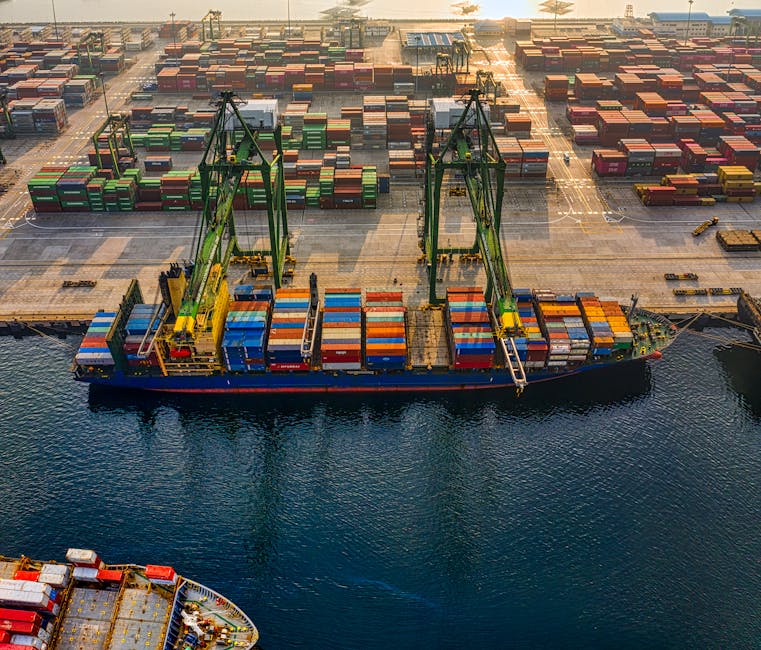Introduction to Less Than a Truck Load Freight
Less Than a Truck Load freight, or LTL, is when your shipment doesn’t fill an entire truck. Think of it as carpooling for cargo. Businesses or individuals only pay for the portion of the trailer their goods occupy, while the rest of the space is filled with shipments from other shippers. This makes LTL a budget-friendly option, especially for small to mid-sized businesses or those who don’t have enough goods to necessitate a full truck. Since you share the truck, costs are shared too. But remember, your shipment will be one of many on board, making stops before reaching its final destination. This means delivery times might be longer compared to full truckload shipments. Overall, LTL is a smart pick if cost efficiency is your goal and you’re not under a tight deadline.
Key Differences Between LTL and Other Shipping Methods
LTL, or Less Than a Truck Load freight, is unique because it allows you to ship smaller amounts of cargo without needing to fill an entire truck. This approach contrasts sharply with full truckload (FTL) shipping. In FTL, you’re paying for the whole truck, whether you fill it or not, making it ideal for large shipments but not cost-effective for smaller loads. LTL, in turn, is more flexible and economical for small to medium-sized businesses or for shipments that don’t require a full truck.
Another key difference is how cargo is handled. With LTL, your goods will likely be loaded and unloaded multiple times as they make their way to the final destination, sharing space with other shipments. This means it might take a bit longer for LTL shipments to arrive compared to FTL, where the cargo goes directly from point A to point B.
Parcel shipping is another method, usually for smaller packages. While it might seem similar to LTL, parcel shipping has its own network and is typically much faster but can get pricey as package size increases.
In summary, LTL is the middle ground, offering a cost-effective solution for shipments that are too big for parcel carriers but too small to justify the cost of an entire truck. It’s about finding the right balance for your shipping needs.
Identifying When to Use Less Than a Truck Load
Knowing when to use Less Than a Truck Load (LTL) freight is like understanding the sweet spot for sending packages. It’s perfect when your cargo is too big for parcel carriers but too small to fill a full truckload. Think of it as sharing a ride. Just like carpooling saves you gas money, LTL saves you shipping costs by sharing the space with other shipments heading in the same direction.
Here’s when you should consider it:
- Your shipment weighs between 150 and 15,000 pounds. That’s the range where LTL shines. Lighter, and a parcel carrier is cheaper; heavier, and you might need a full truck.
- You’re not in a hurry. LTL might take a bit longer since the truck makes several stops to pick up and drop off other shipments. It’s the trade-off for lower costs.
- Your shipment can handle a little extra handling. Since LTL shipments get loaded and unloaded multiple times, make sure your goods aren’t too fragile.
- You’re looking to cut shipping costs. Since you’re only paying for the space you use, LTL can significantly reduce your shipping expenses compared to hiring a whole truck.
Choosing LTL is a smart move for small to medium-sized businesses or any shipper wanting to stretch their shipping budget further. It’s about getting your goods where they need to go without paying for space you don’t need.
How to Prepare Your Shipment for LTL Freight
Getting your shipment ready for Less Than a Truckload (LTL) freight isn’t rocket science, but it does need a bit of planning. First, measure and weigh your cargo accurately. This is crucial because LTL prices depend on these. Next, make sure to pack your items well. Use sturdy boxes, ample cushioning materials, and secure them tightly with packing tape. If your items are on a pallet, wrapping them in shrink wrap keeps everything together during transit. Label your shipment clearly with all necessary details including the destination, return address, and contact information. Lastly, always have a detailed inventory of what’s being shipped. This not only helps in organizing but can be a saver if there are questions about the shipment later. Remember, a well-prepared shipment means less hassle and a smoother shipping process.
Calculating Costs: Factors Affecting Less Than a Truck Load Pricing
When you ship Less Than a Truck Load (LTL), the cost isn’t just a simple flat rate. Several factors come into play that can influence how much you end up paying. First, the weight of your shipment matters. The heavier it is, the more you pay. But, it’s not just about weight; the dimensions of your shipment also affect the price since larger items take up more space in the truck. Next, consider the type of goods you’re shipping. If your items are fragile or require special handling, this can drive up the cost. Location plays a big role too. Shipping to or from remote areas? Expect to pay more than you would for more accessible locations. Additionally, how fast you need your shipment to arrive can impact the cost. Want it there ASAP? That’s going to cost extra. Lastly, extra services like inside pickup and delivery, lift gate service, or residential delivery can add to your total bill. Understanding these factors can help you better estimate the cost of your LTL shipment and possibly find ways to save money.
Booking Your Less Than a Truck Load Shipment: Steps to Follow
Booking your Less Than a Truck Load (LTL) shipment isn’t as complex as it seems. First, figure out the specifics of your freight—this includes size, weight, and type of goods. Next, decide on your shipping needs. Are you in a hurry, or can the delivery take its time? This will affect your cost. Now, find a reliable carrier. Look for those with good reviews and reasonable rates. Once you’ve chosen, you’ll need to prepare your freight. Make sure it’s packed safely and is easily accessible for pickup. Then, book your shipment, providing all the necessary details to the carrier. The final step is to track your shipment. Most carriers offer tracking services, so use them to stay updated. Remember, communication is key. Keep in touch with your carrier to ensure everything goes smoothly.
Packaging and Labeling Tips for LTL Freight
When sending stuff LTL, or Less Than a Truck Load, how you pack and label your freight is critical. Get it right, and your goods arrive safely and on time. Mess it up, and you could face delays, damage, or extra costs. Here’s the deal in simple terms: Pack tight, pack right, and label clear. First off, use sturdy boxes or crates that match the size and weight of your items. Don’t leave empty spaces inside – fill them with packing material to prevent your goods from moving around during transit. This step is vital for avoiding damage. Secondly, consider the journey your freight will take. If it’s fragile, mark it clearly, and use additional padding. Remember, your freight will share space with other shipments. It’s not a solo trip, so pack with the idea that it needs to withstand a bit of jostling. For labeling, be precise and clear. Each piece of your shipment needs a label with the delivery address, contact information, and any special instructions. And here’s a pro tip – place a duplicate label inside the package. If the outside label gets damaged, your shipment won’t be left stranded. Simple packaging and labeling may seem like a small part of LTL Freight, but get it right, and you’re setting yourself up for smooth sailing.
Tracking Your LTL Shipment: What You Need to Know
To track your LTL shipment, clear communication is key. You or your business decided on less than a truckload (LTL) for its flexibility and cost efficiency, right? But what about keeping an eye on your freight? Here’s the deal – most freight carriers offer tracking solutions. Typically, you’re given a tracking number or code right after your goods are dispatched. What you need to do is simple:
- Use the given tracking number and go to the carrier’s website.
- Enter this number into their tracking tool.
Voila, you can now see where your package is, whether it’s still at the warehouse, in transit, or already delivered. But here’s a pro tip: don’t sweat if the tracking info isn’t realtime. It’s common for updates to lag a bit. Why? Because LTL shipments often switch trucks or modes of transport, making it slightly harder to track in real-time compared to direct shipments.
And if stuff goes south, like your shipment is MIA, get on the phone or hit an email to the carrier. Have your tracking code and any other relevant details ready. Being proactive is key. Remember, LTL tracking isn’t rocket science, but staying informed and communicative can save you a lot of headaches.
Common Challenges and Solutions in Less Than a Truck Load Freight
In the world of shipping, choosing Less Than a Truckload (LTL) freight can be a smart move for smaller shipments that don’t need a full truck. But, like any shipping option, it comes with its own set of challenges. Let’s get right into it. One common challenge is higher costs per unit shipped. Unlike Full Truck Load (FTL), where you pay for the full truck regardless of how full it is, LTL costs depend on the space and weight your shipment takes up. So, if not planned well, you might end up paying more per unit. A smart way to tackle this is by consolidating shipments as much as possible to maximize the space and minimize the cost.
Damage risk is another headache. Since your goods are sharing space with others, they’ll be handled more often, increasing the chance of damage. To combat this, proper packaging is crucial. Invest in quality packing materials and consider additional padding for fragile items.
Tracking troubles might also come up. Since LTL shipments can go through multiple hubs or transfer points before reaching their destination, keeping an eye on your goods becomes trickier. The solution? Work with carriers that offer robust tracking systems and keep your communication lines open.
Lastly, delivery delays can be a thorn in your side. LTL shipments often have less direct routes, and with goods from various shippers in one truck, logistics get complicated. To reduce the frustration of delays, always plan for a buffer in your delivery timeline and stay flexible.
In short, while LTL freight shipping is an excellent option for many, navigating its challenges requires some strategy. By understanding the common issues and employing clever solutions, you can make the most out of your LTL shipments.
Conclusion: Maximizing the Benefits of Less Than a Truck Load Shipping
Choosing Less Than a Truck Load (LTL) shipping can save your company both money and resources while also being eco-friendly. By not needing to fill a whole truck, you cut down on costs and reduce waste. It’s also a chance to be more flexible with your shipments, allowing you to ship goods more frequently if needed. To make the most out of LTL shipping, consider consolidating your shipments to minimize fees, plan ahead to avoid higher last-minute rates, and always compare carriers to find the best rates and service for your needs. Remember, understanding your shipping needs and utilizing LTL wisely can significantly impact your bottom line in a positive way.





